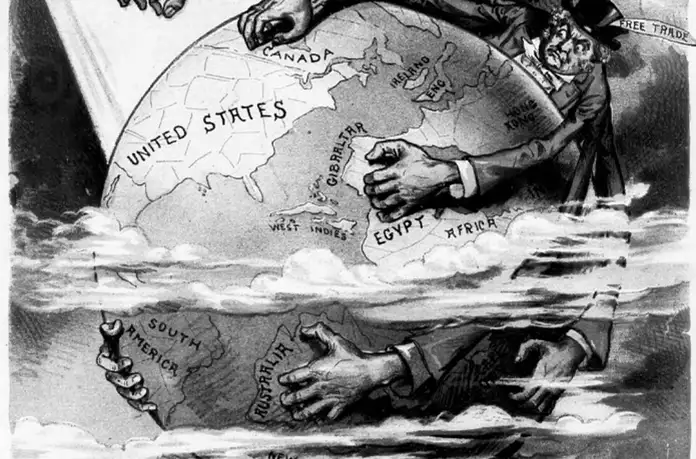- We’re still sitting, waiting, wishing for tariff de-escalation. Trade talks remain underway between several countries and the US… and we’re waiting for announcements. And no one knows if the US trade talks with China have started. Trump says they have. China says they haven’t.
- Timing is of the essence. The longer negotiations take, the longer the global economy remains in a heightened sense of insecurity. And the greater the damage to global growth. The IMF has already started slashing their forecasts for global growth. Talk is cheap, so far, but the economic costs are already mounting.
- The prospect of a global trade war will likely keep downward pressure on prices. Whether that’s a consequence of a slowdown in global economic growth or a diversion of trade marked at a discount. See our Chart of the Week for more.
Picking up from where we left off a fortnight ago, we noted the importance of the trade negotiations that were set to kick off under President Trump’s 90-day pause on reciprocal tariffs. Two weeks later, and we’re still waiting. Though we’re yet to hear of any official action, markets remain skittish on any tariff related news. Reports of Trump lowering the tariff set on Chinese imports from 145% to somewhere in the 50-65% range, provided some relief to market sentiment last week. But the outlook remains murky and confusing with a bit of “he-said-she-said” between China and the US. Trump has asserted and assured that trade talks with China have commenced, while officials in Beijing have claimed no negotiations are underway. Who’s to be believed? It’s anyone’s guess. So, we keep waiting. We’re waiting on talks that will lay the path for global growth from here.
Sideline jabs from Trump towards Fed Chair, J. Powell did cause some volatility. After calling Powell “Mr. Too Late” on rate cuts and branding him a “major loser,” U.S. equities and the Greenback slid amid concerns about the central bank’s independence and potential dismissal of Powell. And then Trump scaled back on the rhetoric, stating he had no plans to fire Powell. It’s mayhem, it's messy and it’s melodramatic. So, we move on.
For now, we’re still on the hinges between our upside and central scenarios. Though in reality, it’s simply timing that differentiates the two scenarios. Because damage already done through heightened uncertainty has already hurt the global economy and outlook. Our upside scenario is hopeful Trump will quickly close out “deals” for most countries lower than the initially stated reciprocal tariffs. But the longer negotiations take, the longer the global economy remains in a heightened sense of insecurity. And the greater the damage to global growth, which is already feeding through now.
The IMF last week slashed their global growth forecasts off the back of tariff turmoil and deteriorating sentiment. The IMF now sees global growth slowing to 2.8% in 2025, down from an earlier estimate of 3.3%. And while the downward revisions span across many countries, it’s advanced economies that are bearing the brunt of the downgrade. Unsurprisingly, the US saw the steepest cut to forecast growth, with a revision to 1.8% for 2025, down from 2.7%. And for 2026, US growth is expected to cool to 1.7%, revised down from 2.1%. On the other side of the trade war, China’s forecast growth was revised down 0.6%pts in 2025 to 4.0%, and another half a percentage point over 2026 to 4.0%. And it’s important to note that Chinese officials target 5%. So, they’re now falling short. More stimulus is now likely. The IMF’s forecasts for New Zealand’s growth rate are yet to be released with the full report out later in May, but with a slowdown across our two largest trading partners, a downgrade to kiwi growth is all but a given.
Financial Markets
The comments below were provided by Kiwibank traders. Trader comments may not reflect the view of the research team.
In rates, markets are slightly calmer
“Slightly calmer in rates markets. Last week saw flatter curves after a rapid +30bp steepening in the US curve (2y vs 10y) over April. The unwind thanks to Trump's remarks to reporters on softening his stance to China tariffs. Sign of stabilisation in short US yields, the 2 year finishing the week where is started while the 10 year fell by around -16bp. NZ rates less exciting, with both 2 and 10 year close to unchanged. Expect more flattening today as rates markets play holiday catch up. In summary some signs of stabilisation, intraday and intraweek ranges remain volatile given the uncertainty and the markets torn view on USD assets. From here expect resilient US data to weaken as tariff realities hit, -89bp of cuts are priced into the US this year.
NZ market prices the OCR down to 2.70% (-80bp of cuts) by year's end. Balanced by a good chance of a +25bp hike in 2026. The sub neutral OCR is expected to work, with the usual cut to hike timeframes of 1 year being respected i.e. last cut priced in Oct/Nov 2025 and first hike priced in Oct/Nov 2026.
As the RBNZ pointed out at the April MPR, inflation and growth will be lower, the surging NZD last week not helping in that regard. Most market commentators now calling for a 2.50% OCR as a result. RBNZ to focus on medium term inflation, that becomes a reality the longer tariffs remain in place and businesses deal with uncertainty. That uncertainty is likely to remain, keeping front end yields pinned and term premium in the curve.” Ross Weston, Head of Balance Sheet – Treasury
In currencies, there’s an unwind of US exceptionalism rather than the demise of the US Dollar
“A reduction in trade tensions between the US and China brought some relief to risk assets during the shortened Easter and Anzac Day week, continuing the theme of investors decoupling the US Dollar from its traditional safe-haven status. The Kiwi dollar briefly touched a post-US-election high of 0.6029 before trending downward, as US equities and Treasuries benefited from various trade related comments from the US administration. Following a roughly 11% decline in the US Dollar Index (DXY) since its January peak, a relief rally seems unsurprising. When examining the recent relative performance of the New Zealand Dollar against its major peers, the CFTC CME speculative positioning data over the past few months offers context. As of the first week of March, net non-commercial (speculative) NZ Dollar futures sat at their shortest recorded level ever. While this buildup of shorts was supported by the RBNZ's aggressive easing cycle, the extreme long position in the USD was reflected across most other major currencies. Over subsequent weeks, the NZD/USD rebounded from below 0.55 to last week's high, with investors cutting short Kiwi positions by around 50%. However, these positions remain relatively short compared to historical levels.
This raises the question: can an ongoing unwinding of US Dollar positioning lead to further gains for the Kiwi? With Fed Chair Powell maintaining a firm stance against easing US interest rates due to inflation concerns, and the RBNZ poised to lower the Official Cash Rate (OCR) to around 2.5–2.75% by year-end, investors are unlikely to adopt overly long Kiwi positions in the near term. Comparing the same CFTC data against the EUR, CHF and JPY— expected major beneficiaries of any decline in the USD's reserve currency status—shows a similar trend. Whilst investors have moved from historically short to historically long JPY positions, the flip also reflects the significant historical changes in BOJ monetary policy rather than solely reactions to US politics. Looking closer to home, perhaps most importantly to understand is that the current CFTC data signals a better equilibrium view of the softer global growth outlook and relative NZ-US interest rate differentials - rather than the extreme bias toward US exceptionalism and owning everything US that had built up prior to Liberation Day.” Hamish Wilkinson, Senior Dealer - Financial Markets.
Weekly Calendar
- Here at home, the April ANZ business survey is the highlight this week. The survey would have captured the Liberation Day tariff announcement, which gives us a first look as to how local businesses perceive the global backdrop. Prior to April, business confidence had been improving, month to month as the RBNZ delivers rate cuts. Uncertainty over the global economic outlook may temper confidence.
- Outside of tariff headlines, US April payrolls is the main data release for financial markets. Job growth is expected to have slowed over the month, with 133k added jobs, down from 228k in March. Professional and business services may see a cyclical rebound in employment growth. However, transportation and logistics may see a pullback, reflecting early impact from the tariff hikes.
- Across the Tasman, Aussie CPI for the March quarter is due out and expected to show inflation cooling. Market consensus expects a 0.8% lift in consumer prices over the quarter. The annual rate is picked to fall to 2.2% from 2.4%, moving below the midpoint of the RBA's 2-3% target band. The trimmed mean measure is also expected to return to the RBA's target band. If inflation cools as expected, it should clear the way for the RBA to cut again at its May meeting.
- China April PMI data are due out this week and may show early signs of damage to the economy from the tariff trade war with the US. The higher US tariffs came into effect in April, and may have pulled the manufacturing PMI back into contractionary territory. Anecdotal reports areflagging a slide in orders and halt to shipments and production in response
- The Bank of Japan will likely keep interest rates unchanged at 0.5% at this week's meeting, given the uncertainty cast over Japan's growth outlook by US tariffs. However, the BoJ is still expected to tighten policy this year given strengthening inflation.
See our Weekly Calendar for more
All content is general commentary, research and information only and isn’t financial or investment advice. This information doesn’t take into account your objectives, financial situation or needs, and its contents shouldn’t be relied on or used as a basis for entering into any products described in it. The views expressed are those of the authors and are based on information reasonably believed but not warranted to be or remain correct. Any views or information, while given in good faith, aren’t necessarily the views of Kiwibank Limited and are given with an express disclaimer of responsibility. Except where contrary to law, Kiwibank and its related entities aren’t liable for the information and no right of action shall arise or can be taken against any of the authors, Kiwibank Limited or its employees either directly or indirectly as a result of any views expressed from this information.




